Despite being selected by the Philadelphia Flyers in the late rounds of the 1994 NHL Entry Draft, he never was invited by the Flyers to participate in a training camp and came to North America as a free agent in 1997. He started in the lower reaches of the minors, first with the Baton Rouge Kingfish of the ECHL. He then joined the Manitoba Moose of the IHL for 14 games, going 8-4-1-1.
Hedberg, born on this date in 1973, also made the roster for Sweden at the 1998 Olympics in February and the World Championships in May.
He returned to Leksands for the 1998-99 season as their number one goaltender, playing in 48 games, as well as a return to the World Championships following the domestic season.
Hedberg was back in North America once again, playing the entire 1999-00 season with the Kentucky Thoroughblades of the AHL, going 18-9-5-3.
He began the 2000-01 season with the Manitoba Moose in the IHL, where he recorded a 23-13-7-1 mark prior to being traded in mid March to the Pittsburgh Penguins by the San Jose Sharks, who had acquired Hedberg's rights from the Flyers back in 1998 and were loaded with goaltending in their system the likes of Evgeni Nabokov, Miikka Kiprusoff and Vesa Toskala.
With Garth Snow dealing with a strained groin and Jean-Sebastien Aubin not playing well, Heberg was given the opportunity to see some action during the end of the regular season. He began with a 41 save performance in a 6-3 win over the Florida Panthers on March 16th, but lost to the Tampa Bay Lightning the next night. Heberg next recorded a tie with Boston before defeating New Jersey, Buffalo, Chicago, St. Louis, Tampa Bay and Carolina to finish the season 7-1-1, creating some excitement in Pittsburgh.
After losing Game 1 and winning Game 2 in Washington, while giving up only 2 goals, Hedberg shut out the Capitals back in Pittsburgh in Game 3. During that game, Hedberg, still wearing his blue mask adored with the smiling moose from Manitoba, was supported by a ever-growing chorus calls of "Moooooose", which was painted in bold letters on the side of his mask.
The Capitals would fall in six games, making "Moose" 11-3-1 in his last 15 games. In the next round, the Sabres would take a 3-2 series lead, only to have the Penguins dig deep and win the series in overtime of Game 7 as the fans in Pittsburgh were now sporting yellow foam antlers as the "Moose" calls continued to become louder and louder. At the peak of the Penguins playoff fever, one fan even altered a sign in a Pittsburgh suburb, changing the name of Heidelberg to "He d berg"!
Hedberg would be the Penguins undisputed number one goaltender the following season in 2001-02, playing in 66 games only now with a mask in the colors of the Penguins, but there would not be another magical playoff run, as Pittsburgh sank in the standings, missing out on the playoffs entirely. That season also saw Hedberg as a member of the 2002 Swedish Olympic team in Salt Lake City.
The following season he was limited to 41 games after suffering an injury.
During the offseason, Hedberg was traded to the Vancouver Canucks, where he backed up Dan Cloutier. He would play just 14 games with Leksands, now down in the second division during the 2004-05 season when the NHL season was cancelled before returning to the NHL with Dallas during the 2005-06 season where he backed up Marty Turco.
He signed as a free agent with the Atlanta Thrashers in 2006-07, playing there for four seasons, the first three behind the often injured Kari Lehtonen and the fourth while splitting time with Ondrej Pavelec.
The next stop for Hedberg was as a backup to Martin Brodeur in New Jersey. Previously backing up Brodeur would have guaranteed a goalie splinters as he would have ridden the bench for 70+ games, but injuries and the need for more rest for the veteran Brodeur meant Hedberg played 34 games in 2010-11 and in the 2011-12 season he was back in the Devils goal for 27 games, finishing with a fine 17-7 record, which allowed him to pass the 150 career wins mark. The lockout shortened 2012-13 season limited him to 19 games, the last of his NHL career, as Hedberg was now 40 years old and he was bought out of the remaining year of his contract after the Devils acquired 27 year old Cory Schneider from the Vancouver Canucks.
Despite not playing in the NHL until age 27, Hedberg played 12 NHL seasons in 373 games with a record of 161-143-36 and a career goals against average of 2.82 and a save percentage of .901.
Hedberg became the goaltending coach for the Devils top minor league affiliate, the Albany Devils of the AHL, which led to him playing one more game in 2013-14, where he gave up 2 goals in two periods of play.
Internationally, Hedberg was named to the Sweden National Team roster on seven occasions, including the World Championships in 1994, 1997, 1998 and 1999, the World Cup of Hockey in 1996 and the Olympics in 1998 and 2002, but each time as a backup, playing in a total of just 3 games.
Today's featured jersey is a 2000-01 Manitoba Moose Johan Hedberg jersey as worn by Hedberg during his time in Winnipeg prior to being traded to the Penguins.
The Moose were originally formed as an expansion team in St. Paul, Minnesota to fill the void created by the departure of the Minnesota North Stars to Dallas. After two seasons of play as the Minnesota Moose, speculation was that the Winnipeg Jets would be relocating to the Target Center in Minneapolis, Minnesota and a plan was put in place to avoid competing head to head with an NHL franchise by moving to the vacated Winnipeg market.
While the Jets never arrived in Minnesota, moving instead to Phoenix, the deal was already in place to send the Moose north to Winnipeg, where they were renamed the Manitoba Moose.
While in Minnesota their dark jerseys were black with purple and forest green trim, but following their move to Canada, the green was given top billing, with black and purple as the secondary colors. In addition, perhaps the greatest font in the history of hockey jerseys was designed for the numbers, each digit incorporating an antler! The jerseys adopted by the Moose during their first season of play in Winnipeg featured a diagonal "check mark" waist stripe, which remained in use through the 2000-01 season, after which the purple color was replaced by copper and the waist stripe changed to a more conventional horizontal stripe.
For the 2000-01 season the Moose were sponsored by Molson Canadian beer and wore a patch on their upper right chest. Additionally, they wore a secondary logo of an "M" with a moose peeking through it. The left side of the M had a maple leaf coming out of it to represent Canada, while the right half of the M was a stylized map of Manitoba.
The team also wore a 5th Anniversary patch on the left shoulder, which was sewn to a large piece of jersey fabric to cover up the stock secondary logo as shown below.
Bonus jersey: Today's bonus jersey is a 1999 Sweden National Team Johan Hedberg jersey as worn in the 1999 World Championships. Jerseys worn in the World Championships quite often have the trademark rectangular sponsorship patches on the upper arms, unlike those worn in the Olympics, which are free from commercial sponsorship.
In today's video section, Hedberg explains how his nickname "Moose" came about.
Next up is Hedberg while playing for Leksands IF during his return to Sweden during the labor stoppage of 2005.
Finally, highlights of Hedberg in action.

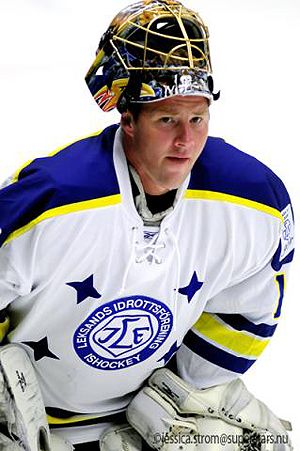
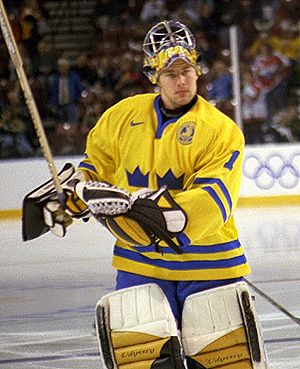
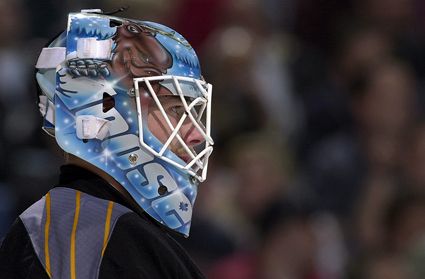


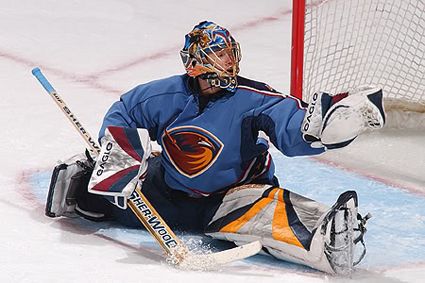

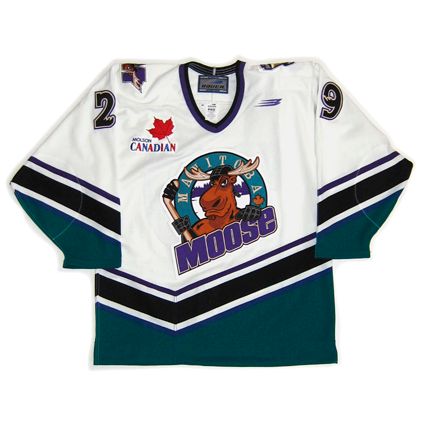
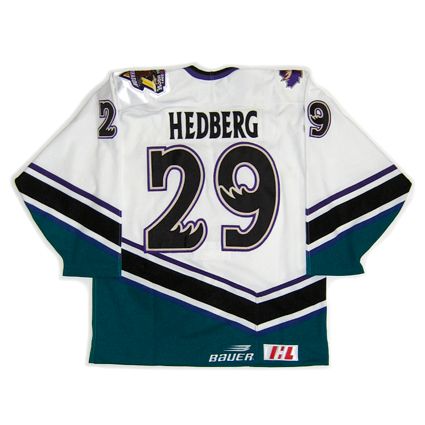
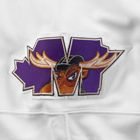
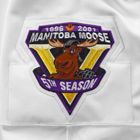

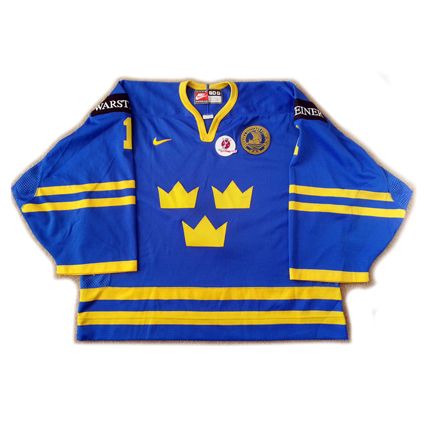
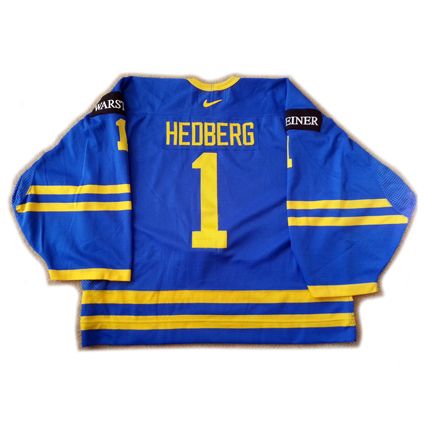










No comments:
Post a Comment
We welcome and encourage genuine comments and corrections from our readers. Please no spam. It will not be approved and never seen.